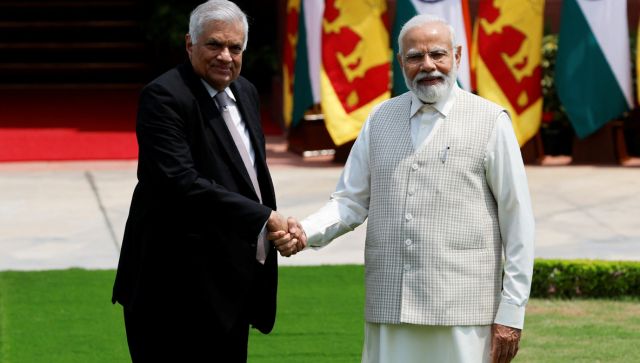After France, India is taking its homegrown digital payments system, Unified Payments Interface (UPI), to Sri Lanka. The two neighbours have signed an agreement on the acceptance of UPI in the island nation, Prime Minister Narendra Modi announced on Friday (21 July) in a joint briefing with Sri Lankan president Ranil Wickremesinghe. Wickremesinghe, who took over as Sri Lanka’s president last July, is on his first official visit to India. “The agreement signed to launch UPI in Sri Lanka will boost fintech connectivity,” the Indian prime minister said. The island nation’s president also thanked Modi for India’s support during Sri Lanka’s worst economic crisis. New Delhi provided $4 billion worth of financial aid through multiple credit lines and currency support.
#WATCH | "The Agreement signed to launch UPI in Sri Lanka, will increase Fintech connectivity," says Prime Minister Narendra Modi. pic.twitter.com/IkzPGGeoMG
— ANI (@ANI) July 21, 2023
Last week, addressing the diaspora in Paris, Modi said India and France have decided to launch UPI in the European country, paving the way for Indian tourists to transact via the online payments facility. Let’s take a look at how UPI works and how India is expanding its digital payments system globally. How to use UPI? UPI lets users make fast, real-time cashless payments. This can be done via a quick response (QR) code or a four or six-digit PIN, with money being directly transferred between the bank accounts of the sender and receiver. India has widely adopted UPI for making payments since its launch a few years back. Daily UPI transactions are likely to reach one billion by 2026-27, accounting for nearly 90 per cent of the total transaction volume in retail digital payments in the country. “It is estimated that UPI will record one billion transactions per day by FY2026-2027, going from 83.71 billion transactions in 2022-23 to 379 billion transactions by 2026-27,” as per PwC India’s 2022 report. In May, the number of
UPI transactions touched a record 9.41 billion, worth a whopping Rs 14.3 trillion in terms of value. The digital payments system is also attracting more and more users to use the facility for quick cashless transactions. Last year, UPI accounted for 73 per cent of all non-cash transactions in India, Economic Times (ET) reported citing Reserve Bank of India (RBI) data. UPI’s global expansion continues India plans to expand its domestic UPI success to other countries. National Payments Corporation Of India (NPCI), which created the
UPI technology, last year signed a memorandum of understanding (MoU) with France’s online payment system, Lyra, for allowing UPI and Rupay Card in the European nation. NIPL, NPCI’s international arm, has been working to help foreign countries develop payment ecosystems, including Person-to-Person (P2P), Person-to-Merchant (P2M), and cross-border payments, noted Business Today. “Why should one reinvent the wheel? We have done it successfully in India and we want to share it with the world,” Ritesh Shukla, CEO of NIPL, told the business magazine last year. In July 2021, Bhutan was the first nation to launch BHIM UPI, the Indian government’s digital payment app. Malaysia’s Merchantrade Asia collaborated with NPCI International to allow real-time remittances to India through UPI the same year. Nepal adopted UPI for digital transactions last March, becoming the first foreign country to do so. [caption id=“attachment_12898352” align=“alignnone” width=“640”] Daily UPI transactions in India are likely to reach one billion by 2026-27. News18 (Representational Image)[/caption] Earlier this year, India linked UPI with Singapore’s payment system, PayNow, for faster remittances between the two countries. This will facilitate people in both countries to send money to each other on a real-time basis. India, the largest recipient of remittances globally, can benefit from UPI’s foreign expansion. “The biggest selling point for UPI internationally is that it could both accelerate and reduce the cost of cross-border transactions to and from India, the world’s top remittances market,” Zennon Kapron, founder and director of Kapronasia, one of Asia’s leading providers of consulting services, wrote for Forbes in April. India signed a deal with the UAE’s Mashreq Bank to help the Indian diaspora pay online through UPI. Notably, the UAE is the second-largest source of remittances to India after the United States. “Wherever we see a huge concentration of Indians, we are working with the payment players in the remittance space,” Shukla told Business Today last year. Last week, India and UAE agreed to link their Fast Payment Systems (FPSs) – UPI and Instant Payment Platform (IPP), respectively – to enable users in each country to “make fast, convenient, safe, and cost-effective cross-border fund transfers”.
#FPVideo: Indian Prime Minister #NarendraModi visited the United Arab Emirates. The two nations signed multiple agreements including settling trade in #rupees and linking the #UPI to #UAE’s digital payments. pic.twitter.com/M3z9wGo3f4
— Firstpost (@firstpost) July 16, 2023
NRIs in countries such as Canada, Hong Kong, Oman, the US, Australia, Singapore, the United Kingdom, Saudi Arabia, and Qatar who have bank accounts types such as Non-Resident External (NRE) or Non-Resident Ordinary (NRO) accounts can also avail UPI services using their international phone numbers. NIPL’s Shukla said last month that UPI is processing 40 per cent of the global real-time payments. In April, NPCI International Payments, a subsidiary of NPCI, forged a partnership with PPRO, digital payments infrastructure provider, for UPI acceptance in global e-commerce payments. NIPL has also partnered with European payment services facilitator Worldline, to expand UPI services across Netherlands, Belgium, Luxembourg and Switzerland. As per reports, India is in talks to take UPI to Indonesia as well as Gulf countries, including Bahrain and Saudi Arabia. With inputs from agencies


)

)
)
)
)
)
)
)
)



